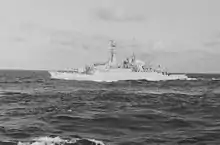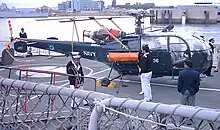 PNS Tippu Sultan, former HMS Avenger | |
| History | |
|---|---|
| Name | HMS Avenger |
| Builder | Yarrow Shipbuilders |
| Laid down | 30 October 1974 |
| Launched | 20 November 1975 |
| Commissioned | 15 April 1978 |
| Decommissioned | 23 September 1994 |
| Homeport | HMNB Devonport |
| Identification | Pennant number: F185 |
| Honours and awards | Falkland Islands 1982 |
| Fate | Sold to Pakistan on 23 September 1994 |
| Name | PNS Tippu Sultan |
| Acquired | 23 September 1994 |
| Identification | Pennant number: D185 |
| Fate | Expended as a target 27 April 2020 |
| General characteristics | |
| Class and type | Type 21 frigate |
| Displacement | 3,250 tons full load |
| Length | 384 ft (117 m) |
| Beam | 41 ft 9 in (12.73 m) |
| Draught | 19 ft 6 in (5.94 m) |
| Propulsion |
|
| Speed | 32 knots (59 km/h; 37 mph) official, 37 knots achievable on bursts |
| Range | 4,000 nmi (7,400 km; 4,600 mi) at 17 knots (31 km/h; 20 mph) |
| Complement | 177 |
| Armament |
|
| Aircraft carried | 1 × Westland Wasp helicopter, later refitted for 1 × Alouette III and 1 × Westland Lynx |
HMS Avenger was a Type 21 frigate of the Royal Navy. Built by Yarrow Shipbuilders Ltd, Glasgow, Scotland, she was completed with Exocet launchers in 'B' position.
Royal Navy service

With the appointment of Captain Hugo White in 1981, Avenger became leader of the 4th Frigate Squadron. Avenger was a late arrival at the Falklands War, as she didn't leave the UK until 10 May 1982, arriving on 25 May - a record for any ship involved in the operations, and a great distance to have covered in 14 days.[1] The Rolls-Royce Olympus turbines of Type 21 frigates enabled them to maintain high speeds, but at the time the Royal Navy preferred this information not to be publicised. Avenger had averaged 28 knots and the Type 21s became nicknamed the Boy Racers.[2] Captain White led Avenger in the Falklands War surviving an attack by an Exocet missile which it shot out of the sky with the 4.5 inch mark 8 gun on the focsle of the ship. Her divers salvaged a 20mm Oerlikon from the wreck of HMS Antelope which was remounted to increase her anti-aircraft capability, referred to on board as "Antelope's Avenger".[3] She also assisted with naval gunfire support during the campaign.
On 11 June she was conducting naval bombardments of Port Stanley in preparation for an amphibious assault by British troops. She directly struck a house where civilians were sheltering, killing three Falkland Islander women and wounding several others. They were the only British civilian casualties of the Falklands War.[4][5]
During the Falklands deployment, an alarming crack in the ship's hull progressively worsened with the stormy South Atlantic weather. On return to UK, she was taken in for refitting, with a steel plate being welded down each side of the ship to eliminate the problem. At the same time modifications were made to reduce hull noise.
On 4 May 1983, HMS Avenger, and sister ship HMS Ambuscade, were on the Royal Navy 'Armilla' patrol, a permanent presence in the Persian Gulf during the 1980s and 1990s. The Avenger's commanding officer, Captain Peter Woodhead, was returning from a visit ashore in the ships Westland Lynx,(registration XZ249) when it suffered a tail rotor control failure and, nose down, plunged into the sea off Muscat, Oman.[6] The Lynx helicopter never resurfaced from its entry into the sea and for a short time there was no sign of the aircrew or ship's captain.[7] As HMS Avenger approached the crash sight the crew observed some green clothed bodies breaking the surface on the water. When it was suggested to the Captain that a Westland Lynx helicopter from the Royal Army of Oman would be taking him and the other three crew members to the nearest hospital in Oman, he informed the medics "there is no fucking way I am getting into that helicopter".[8] Captain Woodhead and the three other crew members survived the incident, with Woodhead sustaining a non-life changing injury to his back.[9]
After the war she remained leader of the 4th Frigate Squadron until 1986.
Pakistan Navy service

Avenger was decommissioned and sold to Pakistan on 23 September 1994, where she was refitted[10] and renamed Tippu Sultan. She was the third ship to carry this name[11] and remained in service with the Pakistan Navy as part of the 25th Destroyer Squadron [12] until on 27 April 2020 she was expended as a target. [13]
Notes
- ↑ Marriott, Leo, 1983. Royal Navy Frigates 1945-1983, Ian Allan Ltd, Surrey, p104
- ↑ "Admiral Sir Hugo White - obituary". Daily Telegraph. 10 June 2014. Retrieved 11 June 2014.
- ↑ Marriott, Leo, 1983. Royal Navy Frigates 1945-1983, Ian Allan Ltd, Surrey, p104
- ↑ Steven P. Lee (13 February 2012). Ethics and War: An Introduction (Cambridge Applied Ethics). Cambridge University Press. p. 33. ISBN 978-0-5217-2757-0.
- ↑ "Falklands War memorial unveiled at National Arboretum". BBC. 20 May 2012. Retrieved 19 July 2013.
- ↑ Ranter, Harro. "Incident Westland Lynx HAS2 XZ249, 04 May 1983". aviation-safety.net. Retrieved 12 May 2022.
- ↑ "HMS Avenger (F185) | Type 21 Club". Retrieved 12 May 2022.
- ↑ "HMS Avenger (F185) | Type 21 Club". Retrieved 12 May 2022.
- ↑ "HMS Avenger (F185) | Type 21 Club". Retrieved 12 May 2022.
- ↑ "Pakistan". globalsecurity.org. Retrieved 17 January 2009.
- ↑ The Pakistan Society newsletter, October 2005 Archived 2 September 2009 at the Wayback Machine
- ↑ Pakistan Navy: A Silent Force to Reckon with Archived 29 January 2009 at the Wayback Machine
- ↑ Editorial, Defense Brief (28 April 2020). "Pakistan sinks former Royal Navy frigate in missile firing drill". Defense Brief. Retrieved 30 December 2022.
Publications
- Colledge, J. J.; Warlow, Ben (2006) [1969]. Ships of the Royal Navy: The Complete Record of all Fighting Ships of the Royal Navy (Rev. ed.). London: Chatham Publishing. ISBN 978-1-86176-281-8.
- Marriott, Leo, 1983. Royal Navy Frigates 1945-1983, Ian Allan Ltd, Surrey. ISBN 978-0-7110-1322-3